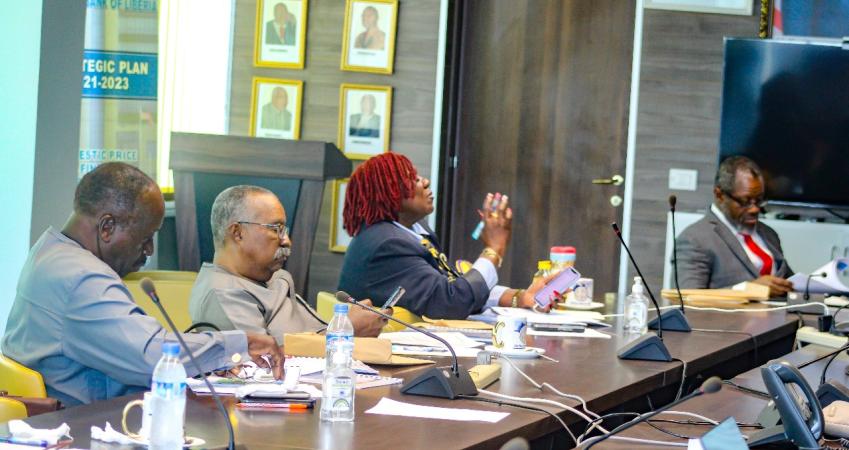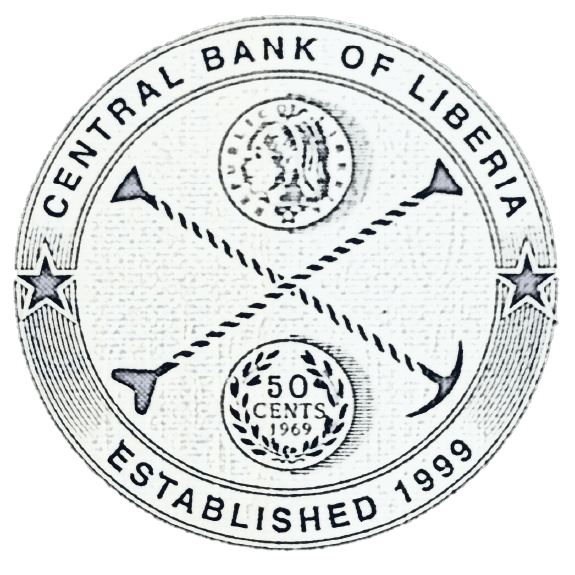
The Central Bank of Liberia (CBL) Board of Governors, proxying for the Monetary Policy Committee (MPC), held its second MPC meeting of 2024 on May 15th, 2024. The Board assessed the macroeconomic conditions of the domestic and global economies for the 1st quarter of 2024, to guide the policy decisions for the next quarters during the year.
Global Macroeconomic Developments
The Board acknowledged the resilient recovery of the global economy despite uneven growth among regions and headwind challenges. Characterized by supply-chain disruptions, lingering pandemic effects, the Russia-Ukraine war that sparked energy and food crisis, and a surge in inflation that triggered tight monetary policy globally, the Board was impressed with the projected growth rate of 3.2 percent growth of global Real Gross Domestic Product (RGDP) attributed to growth in the advanced economies, especially the euro area and the United States. However, the Board was concerned about the expected slowdown in China which could have a spill-over effect on the Liberian economy due to China being one of the country’s major trading partners. The Board noted the projected improvement in Sub-Saharan Africa, as growth is expected to rise to 3.8 percent in 2024 and the robust forecasts for countries in the West African Monetary Zone (WAMZ) with all WAMZ countries are expected to grow beyond their 2023 levels.
Global inflation continues to moderate from a peak of 8.7 percent in 2022 to 6.8 percent in 2023 and a projection of 5.9 percent for 2024. The moderation in inflation highlights the resilience of monetary policy, mainly in the advanced economies. In low-income countries, inflation is still high due to pass-through effects of higher food, fuel, and fertilizer costs. Sub-Sahara Africa inflation was still high, even though it is projected to moderate to 15.3 percent for 2024 from 16.2 percent in 2023. Hence, maintaining tight policy rates in response to containing inflation remains the key policy response for many central banks.
The Board noted the favorable developments in commodity prices. All of the selected agriculture commodity prices rose in the quarter under review one except the round logs, compared to the last quarter in 2023; in the metal & energy category gold price rose, while crude oil and iron ore prices declines compared to the last quarter in 2023.
Domestic Macroeconomic Developments
Assessment of the domestic economy recorded slight growth in quarter one with a Real GDP growth rate of 0.9 percent from 0.5% growth rate recorded in the last quarter in 2023. This growth rate was on account of the quarter-on-quarter moderation in average consumer price and the relative stability in the exchange rate, coupled with strong production during the quarter. However, consumption was weak compared to the previous quarter. The assessment showed that economic activity is expected to be strong in the second as the 2024 National Budget becomes fully operational.
Headline inflation slightly declined to 10.3 percent from 10.5 percent in quarter four of 2023. The Board noted that the slight moderation in consumer prices was mainly driven by weak demand and low government expenditure during the quarter. However, forecast for quarter two 2024 projects an uptake in inflation to 10.9 percent with a symmetric band of +/- 2 percentage points in anticipation of rising government and consumer spending.
The banking industry reported growth in key balance sheet items. The industry remained well capitalized and liquid. Total loans and advances, total assets (gross), total deposits and total capital increased by 1.8%, 2.1%, 4.9% and 6.3%, respectively, during the quarter under review. Although non-performing loans (NPLs) declined by 2.6 percentage points from 18.1 percent to 15.5 percent, the current level of NPLs was still above the minimum regulatory limit of 10 percent. The assessment, as noted by the Board, also showed that savings and time deposits remain low, reflecting the shallow nature of the Liberian financial system.
The Board was concerned that credits to the private sector in both currencies declined during the quarter under review. It was noted that private sector credit in Liberian dollars fell by 20.2 percent to 0.51% of GDP from 0.65% of GDP in the previous quarter on account of declines in credits to services, manufacturing, and agriculture & fisheries. Also in US dollars, private sector credit fell by 2.1 percentage points to 10.0% of GDP compared to the 10.6% of GDP in the previous quarter driven by declines in credits to manufacturing and mining & panning.
Monetary Aggregates and Financial Markets Developments
The assessment of monetary developments showed that expansion in monetary aggregates was relatively moderate with broad money supply (M2) growing by 2.5 percent on account of 1.6 percent rise in narrow money (M1). Currency in circulation (CIC) declined by 9.9 percent to L$28.3 billion from L$31.4 billion recorded in quarter four of 2023, while currency outside banks (COB) declined by 14.3 percent to L$25.3 billion from the L$29.5 billion recorded in the last quarter of 2023. The declines in CIC and COB saw currency in banks (CIB) rising significantly to L$3.0 billion from L$1.9 billion in quarter four 2023. These developments were mainly triggered by slowdown in economic activity compared to the previous quarter.
Regarding developments in the financial markets, the assessment reported that retail subscriptions for CBL Bills rose by 20.1 percent to L$607.0 million from L$505.5 million in quarter four 2023. However, it was noted that institutional investors subscription contracted by 12.1 percent to L$15.6 billion from the L$17.8 billion in quarter four of 2023, thus bringing the total subscription down by 11.2 percent. For the period under review, the interbank market recorded USD3.0 million lending transactions at 3 percent, USD9.0 million placements at 3.0 percent, and 11 LRD placements at 9 percent. There were two 2 repo transactions in US Dollars at 4.5 percent and USD20.0 million SWAP transactions. The activity in the interbank market showed significant improvement compared to the previous quarter as there were no transactions recorded in the last quarter of 2023.
External Sector and Exchange Rate Developments
During the deliberations, the Board was satisfied with the improvement in the external sector as provisional statistics showed significant decline in trade deficit by 51.0 percent, representing 5.0% of GDP from the 10.7% of GDP recorded in quarter four 2023 on account the reduction was on account of 35.0 percent declined in merchandise imports despite the 7.7 percent decline in export receipts. The gross international reserves (GIR) declined by 6.4 percent to US$422.2 million, while the months of import cover rose to 2.3 months, above the 1.7 month in the last quarter of 2023. Net workers’ remittance inflow increased by 12.7 percent rise in net workers’ remittance inflow to US$213.0 million. This helped to maintain the stability of the local currency during the quarter.
The assessment for the period under review showed that the Liberian dollar on average depreciated by 1.7 percent to L$190.77/US$1.00 in quarter one 2024, while the end-of-period recorded a 2.7 percent deprecation to L$192.8/US$1.00 at end-March 2024 from L$187.68/US$1.00 and L$188.50/US$1.00 in quarter four and at end-December 2023, respectively. However, the Board was concerned about the risk of depreciation of the Liberian dollar, noting that the depreciation is most likely to have an exchange rate pass through effect into prices.
MPC Decisions
Following its deliberations, the Board of Governors noted the significant improvement in the global economy, moderation in global inflation, decline in crude oil and iron ore prices as well as the rise in agricultural produce prices. The Board welcomed the quarterly growth estimates of the Liberian economy but expressed concerns about the projected inflation and expected government expenditure for the second quarter.
Based on the foregoing, the Board took the following decisions:
- To maintain the Monetary Policy Rate (MPR) at 20 percent to contain a potential build-up of inflationary pressures in the economy;
- To maintain the reserve requirement ratios of 25% and 10% for Liberian and US dollars, respectively, aimed at controlling the level of Liberian dollars in circulation and contain the pressure on the domestic currency;
- To encourage the commercial banks to support lending to the productive sectors; and
- To sustain efforts including review of Regulation Concerning Prudential Regulations for Asset Classification Provisions for Loan Losses and Suspension of Interest on Non-Performing Loans and Advances for the effective implementation of policies (including monitoring, recovery, loan write offs, restructuring and the use of credit infrastructures) to improve lending to the private sector, which is the engine of growth and employment.
In closing, the CBL will continue to monitor developments in the domestic and global economies, and will take the necessary and appropriate policies to promote and maintain macroeconomic stability.
Signed: _______________________________________
J. Aloysius Tarlue, Jr.
Executive Governor & Chairman of the MPC
